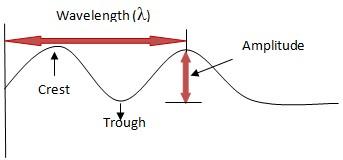Wave:
A disturbance that moves through a medium when the particles of the medium set neighboring particles into motion, are called wave.
During propagation of wave, disturbance created in any part of the medium travels through the medium and not the particles of the medium. Particles of the medium only displace or oscillate about their equilibrium positions. After the disturbance has passed through any particle, it comes back to its equilibrium position.

A peak is called the crest and a valley is called the trough of a wave.
The linear distance between any two points or particles having phase difference of 2π rad is called the wavelength (λ) of the wave.
Wave number (1/ λ ) is the number of waves per unit distance.
Wave frequency (ω) of the wave is the frequency of oscillation (f = 1/T) of the particles of the medium.
ω = 2π f
ω is the angular frequency of the wave.
Angular wave number = 2π/ λ. It is also called as propagation constant or wave vector k.
Wave speed (v) = Distance/time = λ/T

Amplitude of wave is defined as the amplitude of oscillations of particles of the medium.
Propagation of energy: Energy passing through a unit area taken in the direction normal to the propagation of the wave in one second is called the intensity of wave is directly proportional to the square of its amplitude.
Types of waves:
1. Mechanical waves
Wave which require medium like air, water, steel for propagation is called mechanical wave. In this types of wave, particles of the medium experience oscillatory motion due to elastic property of the medium.
Ex – Sound wave
2. Non-mechanical waves
Wave which do not require medium for propagation and travels directly in the electric and magnetic field is called non-mechanical waves.
Ex – light wave
3. Transverse wave
Wave in which oscillations are in a direction perpendicular to the direction of wave propagation is called the transverse waves. Particles of wave do not oscillate along the line of wave propagation, but oscillate up and down.
Ex – Light wave
4. Longitudinal wave
Wave in which the oscillations are in a direction along to the direction of wave propagation is called the longitudinal wave. Particles of wave do not move from one place to another but oscillate back and forth about their position of rest.
Ex – Sound wave
Calculations:
Ex-1: Match the following
|
A
|
B
|
|
Longitudinal wave
|
Transverse wave
|
|
Transverse wave
|
Mechanical wave
|
|
Sound
|
Particles oscillates up and down on the line of wave
|
|
Light
|
Particles oscillates back and forth along the line of wave
|
Answer:
|
A
|
B
|
|
Longitudinal wave
|
Particles oscillates back and forth along the line of wave
|
|
Transverse wave
|
Particles oscillates up and down on the line of wave
|
|
Sound
|
Mechanical wave
|
|
Light
|
Transverse wave
|
Ex-2: Intensity of wave is directly proportional to the ……………….
a) Square of amplitude
b) Square root of amplitude
c) Square of wave number
d) Square of wavelength
Answer: Intensity of wave is directly proportional to the square of its amplitude
Ex-3: The frequency of the FM 94 is 96.7 MHz. Find wavelength and angular frequency of wave. Here speed of FM radio waves in air is 3 x 108 m/s.
a) 3.112 m and 6.07 x 108 rad/s
b) 3.102 m and 6.07 x 108 rad/s
c) 3.122 m and 6.08 x 108 rad/s
d) 3.112 m and 6.00 x 108 rad/s
Answer:
Wave Speed v = 3 x 108 m/s
f = 96.7 MHz = 96.7 x 106 Hz
Wave length = v/f = 3 x 108/96.7 x 106 = 3.102 m
Angular frequency ω = 2π f = 2 x 3.14 x 96.7 x 106 = 6.07 x 108 rad/s